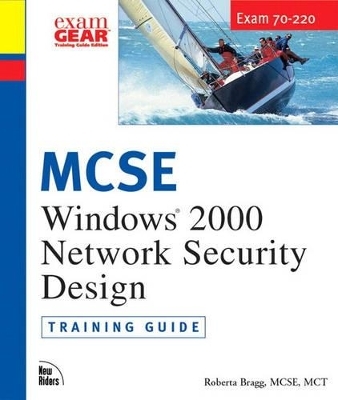
MCSE Training Guide (70-220)
New Riders Publishing
978-0-7357-0984-3 (ISBN)
- Titel ist leider vergriffen;
keine Neuauflage - Artikel merken
Exam 70-220, Designing Security for a Windows 2000 Network tests the skills required to analyze the business requirements for security and design a security solution that meets business requirements. Security includes controlling access to resources, auditing access to resources, authentication, and encryption. Ideal for you, professionals looking for comprehensive self-study materials to get you through the exam successfully. Years of publishing in theis category has shown us that the most asked-for type of study information comes in the comprehensive, study-at-your-own-pace package. New Riders Training Guides, with their objective coverage, emphasis on hands-on knowledge, and practice exams, are an ideal tool for this audience.
Roberta Bragg, MCSE, MCT, is a freelance writer for MCP Magazine. She is currently working on a Security title for the Landmark series. Prior to becoming a full-time writer, she worked at Advanced Technology Solutions on security issues in a mixed NT/Unix environment. She is certified to teach more than two dozen topics and is an experienced technical curriculum developer with special interests in security, operating systems, and databases.
I. ANALYZING BUSINESS REQUIREMENTS.
1. General Business Analysis.
Introduction. Analyzing Existing and Planned Business Models. Analyzing Existing and Planned Organizational Structures. Analyzing Factors That Influence Company Strategies.
2. Analyzing.
Introduction. End-User Requirements. IT Management. Physical and Information Security Models. Security Risks.
II. ANALYZING TECHNICAL REQUIREMENTS.
3. Analyzing Technical Environments.
Introduction. Analyze Company Size and User and Resource Distribution. Assess Available Connectivity. Identify Network Topology. Assess Net Available Bandwidth. Analyze Performance Requirements. Analyze Data and Systems Access Method. Analyze Network Roles and Responsibilities. Analyze the Security Design.
III. ANALYZING SECURITY REQUIREMENTS.
4. Designing a Security Baseline.
Introduction. Active Directory Introduction. Understanding Security Templates and Computer Policy Introduction. Creating or Modifying Security Templates Using Security Configuration and Analysis. Domain Controllers Baseline. Operations Master. Servers. Desktop Computers. Kiosks. System Services Template Settings. Registry and File System. Installing Computers with Enhanced and Appropriate Security. Using Secedit to Apply and Analyze Security Settings.
5. Securing Resources.
Introduction. Applying Security to File Systems. Analyzing Printer Permissions. Analyzing Registry Keys Access. Examining Dial-In Access. Internet Access. Active Directory Schema Permissions.
IV. DESIGNING A WINDOWS 2000 SECURITY SOLUTION.
6. Designing an Audit Policy.
Introduction. Designing an Audit Policy. What Can Be Audited?. Objects to Watch. Using Periodic or Fixed-Frame Audit Techniques. Configuring Auditing. Determine How You Are Going to Cope with the Multitude of Records Produced.
7. Designing a Security Group Strategy.
Introduction. Built-In Users. Types of Groups and Group Scope. Default Groups. Using Security Groups to Provide Resource Access. Restricted Groups. Terminal Services. Tools for Managing Users. User Rights and Privileges. Delegation of Authority.
8. Designing Security Policy Inheritance.
Introduction. What Is Group Policy? Group Policy Application. Group Policy Inheritance. Controlling Group Policy with Group Policy. Client-Side Processing. Policies for Windows NT and Windows 9x Computers in a Windows 2000 Domain. Design. Testing and Documenting Group Policy. Best Practices.
9. Designing an Encrypting File System Strategy.
Introduction. Revisiting ITS. Encrypting Files—User Processes. Encrypting File System Internals. Recovery Policy. The cipher Command. Designing a Strategy for EFS. Best Practices.
10. Designing an Authentication Strategy.
Introduction. Windows 2000 Security Model. Kerberos—Native Windows 2000 Authentication. Native Mode versus Mixed Mode. NTLM, LM, and NTLMv2. Using NTLM for Downlevel Clients. Digest Authentication. Using Certificate-Based Authentication. Smart Cards and Biometrics. What Does a Smart Card Do? Integration with Windows 2000 Kerberos. Integration with Windows 2000 PKI. SSL. RADIUS: Internet Authentication Service. Windows 2000 Kerberos Interoperability. Windows 2000 PKI Interoperability. Windows 2000 and Macintosh Interoperability. Windows 2000 Novell Interoperability. Windows 2000 UNIX Interoperability. SNA Server and Authentication in the IBM Mainframe and AS/400 World. What Works for You?
11. Designing a Public Key Infrastructure.
Introduction. Basic Definitions. Windows 2000 PKI. Certificate Server Roles. Installing Certificate Services. Configuring a CA. Certificate Authority Hierarchies. Certificate Lifecycle—Managing Certificates. Mapping Certificates. Third-Party Integration.
12. Designing Windows 2000 Network Services Security.
Introduction. DNS Security. RIS Security. SNMP.
V. DESIGNING A SECURITY SOLUTION FOR ACCESS BETWEEN NETWORKS.
13. Providing Secure Access Between Networks.
Introduction. NAT and Internet Connection Sharing. Routing and Remote Access Services. Internet Authentication Services. Virtual Private Networking. Terminal Services.
14. Designing Security for Access Between Networks.
Introduction. Secure Access to Public Networks. Secure Access to Private Network Resources. Secure Access Between Private Networks. Windows 2000 Security for Remote Access Users.
15. Designing Security for Communication Channels.
Introduction. SMB Signing. IPSec.
VI. FINAL REVIEW.
Fast Facts.
Analysis and Security Requirements. Security Templates. Encrypted File System. Public Key Infrastructure. Network Services Security. Providing Secure Access Between Networks. Designing Security for Communication Channels.
Study and Exam Prep Tips.
Learning Styles. Study Tips. Exam Prep Tips. Final Considerations.
Practice Exam.
Exam Questions. Answers to Exam Questions.
VII. APPENDIXES.
Appendix A. Glossary.
Appendix B. Overview of the Certification Process.
Types of Certification. Certification Requirements.
Appendix C. What's on the CD-ROM.
ExamGear, Training Guide Edition. Exclusive Electronic Version of Text. Copyright Information and Disclaimer.
Appendix D. Using the ExamGear, Training Guide Edition Software.
Exam Simulation. Study Tools. How ExamGear, Training Guide Edition Works. Installing and Registering ExamGear, Training Guide Edition. Using ExamGear, Training Guide Edition. Obtaining Updates. Contacting New Riders Publishing. License Agreement. License. Software and Documentation. License Term and Charges. Title. Updates. Limited Warranty and Disclaimer. Limitation of Liability. Miscellaneous. U.S. Government Restricted Rights.
Index.
| Erscheint lt. Verlag | 15.8.2000 |
|---|---|
| Sprache | englisch |
| Maße | 214 x 242 mm |
| Gewicht | 1950 g |
| Themenwelt | Informatik ► Betriebssysteme / Server ► Windows |
| Informatik ► Betriebssysteme / Server ► Windows Server | |
| Informatik ► Netzwerke ► Sicherheit / Firewall | |
| ISBN-10 | 0-7357-0984-X / 073570984X |
| ISBN-13 | 978-0-7357-0984-3 / 9780735709843 |
| Zustand | Neuware |
| Haben Sie eine Frage zum Produkt? |